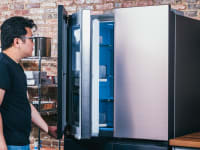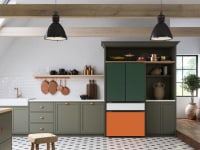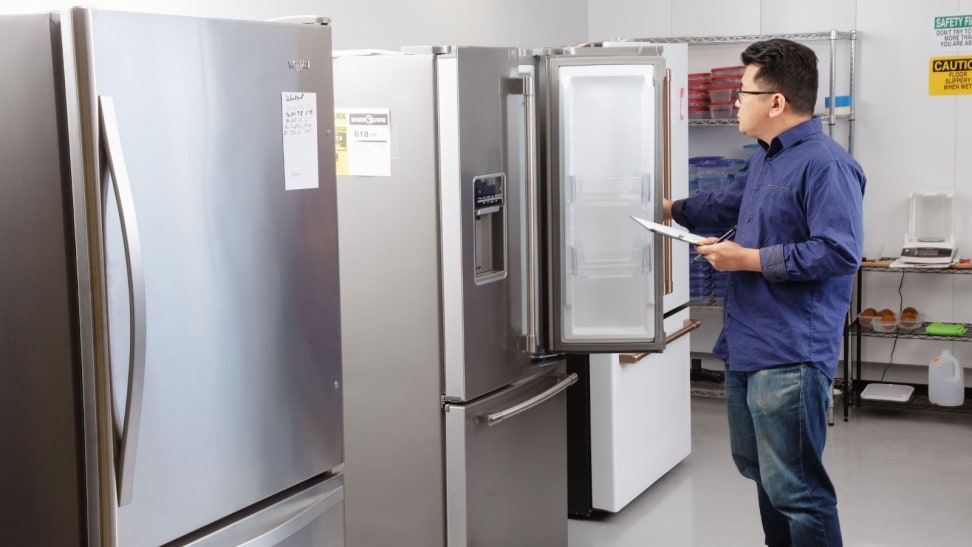 Credit:
Reviewed / Timothy Renzi
Credit:
Reviewed / Timothy Renzi
Products are chosen independently by our editors. Purchases made through our links may earn us a commission.
Reviewed's lab team has spent more than a decade testing large appliances, including washers, dryers, dishwashers, and, of course, refrigerators. In fact, over these years, we estimate that we’ve spent 12,000 hours testing all makes and models.
From a variety of popular brands—Frigidaire, Samsung, Bosch, GE, KitchenAid, Electrolux, and Hotpoint, among them—to the most commonly used styles—French-door fridges, side-by-side fridges, top-freezer fridges and even mini fridges—our experience knows no bounds.
When a refrigerator comes into our testing labs, we put it through a rigorous science-based testing process that we developed ourselves, and overseen by Reviewed’s chief scientist, David Ellerby, PhD, from the top of the freezer to the bottom of the crisper drawers.
Our rigorous testing is part of why you can trust our reviews, and how we're able to confidently assert that one fridge is better than another.
Here is a quick overview of how we test refrigerators in the Reviewed lab and a glimpse into the rationale of what we do.
Our testing facility: The Reviewed Lab
Want to know what makes Reviewed stand apart from competitive product review sites like Wirecutter, Cnet, The Spruce, and Better Homes & Gardens? We go beyond user experience, travel farther than a home improvement store floor. We bring large appliances like refrigerators into our Cambridge, Mass., testing facility, and we run them through a rigorous testing process based in science and compliant with industry standards. Our own chief scientist and our lab technicians gather data and use it to form assessments, which result in our findings. This process puts us in the ranks of product testing legends, Consumer Reports and Good Housekeeping.
When it comes to refrigerators specifically, we test in a controlled environment kept at a temperature of 72°F and a relative humidity of 50%. This ensures that all the ambient conditions for all the fridges we test are the same year round. We also base some of our tests on industry standards set by AHAM, including the guidelines around temperature consistency and moisture retention.
Most importantly, we test in a consistent environment of temperature and humidity
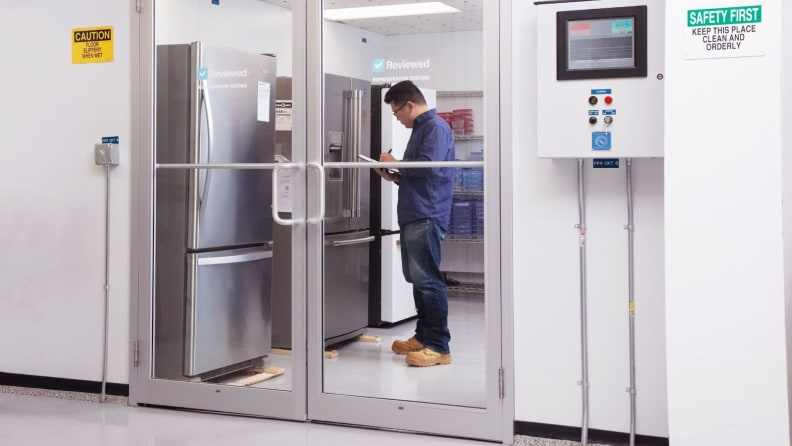
Our refrigerator lab keeps both temperature and humidity levels even, to ensure our results are comparable all year, regardless of external conditions.
The first and arguably most important element of how we test is our refrigerator lab itself. This sealed room is connected to a system that automatically maintains a constant 70°F temperature and 50% relative humidity, regardless of how hot and dry or cold and wet it may be outside.
Keeping environmental factors consistent is extremely important, because variations in temperature and humidity can affect how hard a fridge needs to work.
For example, if it's hot and humid outside, a fridge will have significantly more difficulty radiating away the heat it's removing from its contents. If it can't radiate away heat fast enough, it can't keep up with cooling, resulting in that fridge having a worse overall score than it would have had on a colder day. This means the performance of a fridge we tested a few years ago in winter can be directly compared to the performance of a fridge we tested last summer.
Temperature test: We measure temperature fluctuations over time
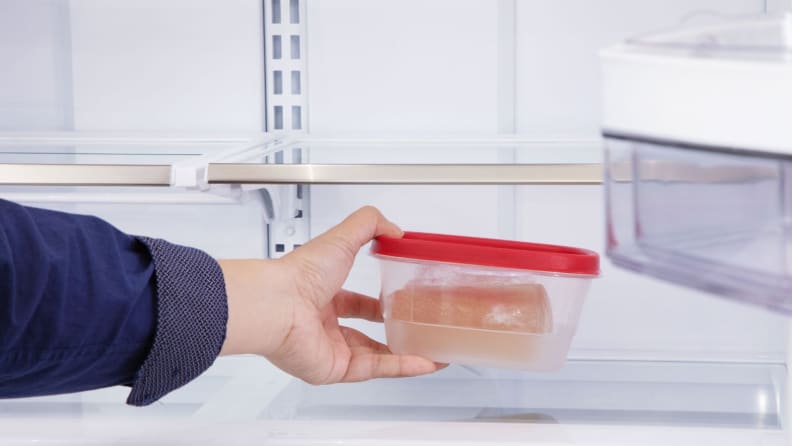
Our senior manager of lab operations adds a testing button imbedded in ballast to the fridge. This gives us a more accurate measurement of how the internal temperature of your food is changing, not just the temperature of the air around it.
Ideally, your fridge should be exactly 37°F and your freezer should be at 0°F. A good fridge can maintain these temperatures consistently, both throughout the fridge and the freezer (with no warm spots) over time.
The reason these temperatures are important is because any variance can ultimately affect the shelf life of your food. When a fridge's temperature rises above 40°F, you enter the bacteria “danger zone”, where microbes can reproduce significantly faster, speeding up the spoiling process.
Temperatures in the fridge also can't fall below 32°F or else some items will start to freeze. That means your fridge needs to keep temperatures within a relatively narrow band of just 8°F. And that's with users opening up the door every so often to grab a bite to eat, plus necessary defrost cycles to keep everything running smoothly. It's a surprisingly exacting task.
Ellerby notes, “Your fresh produce is going to spoil, but a well-designed fridge makes sure it does so as slowly and safely as possible. Temperature control is vital for this. Fridges don’t just need to be cold, but they also maintain the same temperature everywhere in the fridge and keep it stable over time. That’s why we spend days carefully monitoring fridge temperatures at multiple locations.”
Your freezer doesn't have it much easier, although the challenges it faces are different. Temperatures need to stay at 0°F to ensure everything is properly frozen. Keeping the temperature lower doesn't hurt anything, but it does mean you're wasting that additional energy.
The unique problem freezers face is freezer burn. Freezer burn is caused by inconsistent freezer temperatures allowing food to partially thaw, then refreeze. This process gradually extracts the water content from your food, essentially dehydrating it in the process. This is why freezer-burned food often has a snowy/icy build-up on its outside.
To test temperatures, we first calibrate both the fridge and freezer to be as close to the ideal temperature as possible. We then collect temperature data throughout the week using sensors embedded in a methylcellulose block, which is basically just a non-spoiling stand-in for a hunk of meat.
The reason we embed the sensors in methylcellulose is because we're more interested in the internal temperature of your food, which changes more slowly over time, as opposed to the ambient air temperature, which is constantly changing.
And, because fridges exist to be used, we also stop by every so often to open up the fridge door, simulating its owner pondering what they'd prefer to snack on.
Crisper test: Do they actually keep veggies crisp?
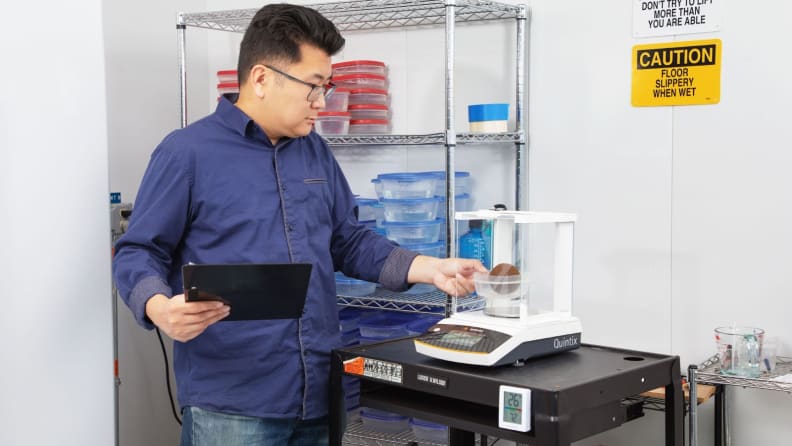
Weighing the floral foam ball lets us measure how much water it was able to retain after a while in the fridge's crisper, allowing us to figure out the rate at which humidity escapes.
Crispers don't usually get a lot of attention, even from ardent vegetarians. The truth of the matter is that a great crisper can keep your leafy greens from wilting for far longer than a bad crisper.
To test how good your crisper is at maintaining humidity, we add water to a floral foam ball, then measure how quickly it dries.
“Cold air doesn’t hold much moisture, so your fridge is a dry environment,” explains Ellerby. “This could make it a terrible place to store salad leaves and soft-skinned fruit like grapes. Crisper drawers try to solve this problem by trapping moisture and protecting produce. Therefore, we measure how quickly moisture escapes from each crisper drawer to assess whether a fridge can keep your salads fresh.”
Humidity matters because if the crisper is too dry, your leafy greens will quickly dry out; if it's too humid, your fruits will rot. Fridges that strike a balance between the extremes will preserve your fruits and veggies for longer.
Usable storage space test: We manually measure everything
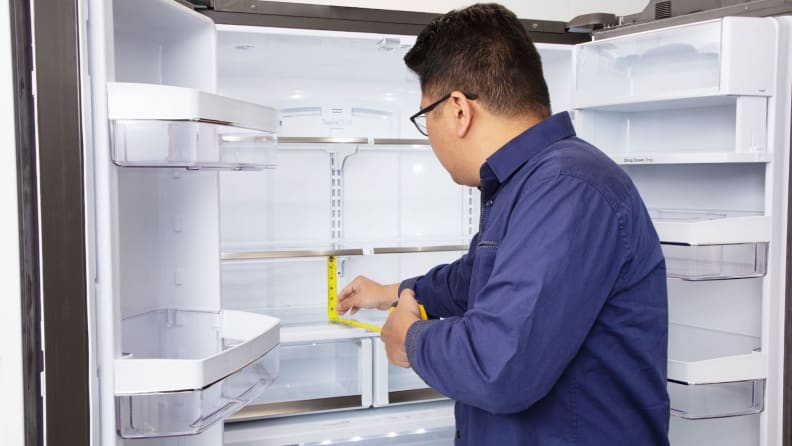
The typical way manufacturers state storage capacity isn't reflective of how much storage space you can actually use. Because of this, we manually measure each compartment and to calculate how much storage space you're actually getting.
This test may not make much sense initially. If you were to go to just about any manufacturer's site and look up a specific model of fridge, they'll often include its storage capacity in big font right at the top as well as in the spec sheet.
Then why manually measure every nook and cranny of the fridge manually when we could just use those numbers?
The answer is twofold. For starters, there's no industry-wide standard for how to perform this measurement. Most manufacturers measure the interior of a fridge by essentially flooding it with water, and then measuring the volume of that water, but that doesn't mean every manufacturer needs to use this method.
Second, while the methodology of flooding the fridge does make a kind of sense, it doesn't reflect how you'd actually use the fridge in real life. Water fills every available space, whether it's around a light bulb, in the space between the icemaker and the wall, and the void between the shelves and the door bins.
By manually measuring, with an old-fashioned tape measure and pencil, we're ensuring the data is both more consistent between different manufacturers and also providing a number that's more accurate to how much space you're actually getting to store your food.
Freezing test: How fast can the freezer drop down its temperatures?
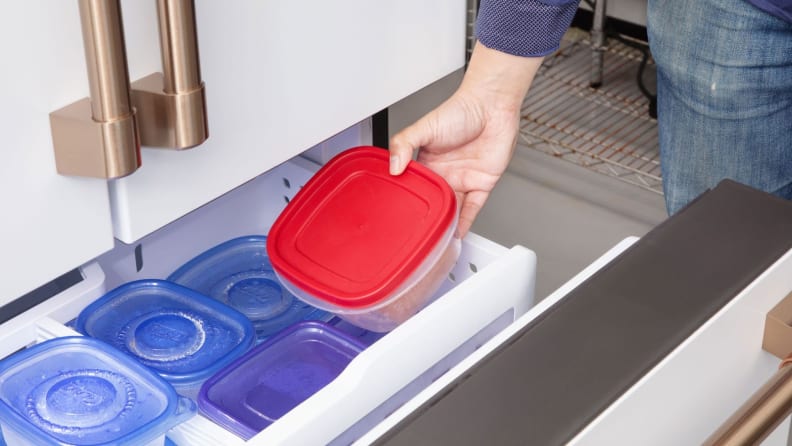
We use ballast containers in both the fridge and freezer, made from methylcellulose and ice respectively. This is because a lot of your fridge's temperature consistency depends on there being actual items in each compartment to help retain the temperature.
Once the fridge is plugged in, we measure the time it takes for the freezer to cool down from room temperature to 32°F (the freezing temperature of water).
This is a good measure of how quickly your fridge and freezer can cool down food or beverages that have just been placed inside the refrigerator. As we mentioned above, allowing frozen foods to defrost and then refreeze can dry them out.
Efficiency test. How energy efficient is it —and how much it may cost you
Using an electric meter, we measure the fridge’s energy usage (in Watt-hours) over the week of testing. Knowing a fridge's energy usage lets us calculate how efficient the fridge is, which lets us figure out how much money buying it may save customers on their future utility bills.
One quick thing to check for is Energy Star certification, which indicates that a product uses a certain percentage less energy than federal requirements.
UX test: Using a fridge just like you would
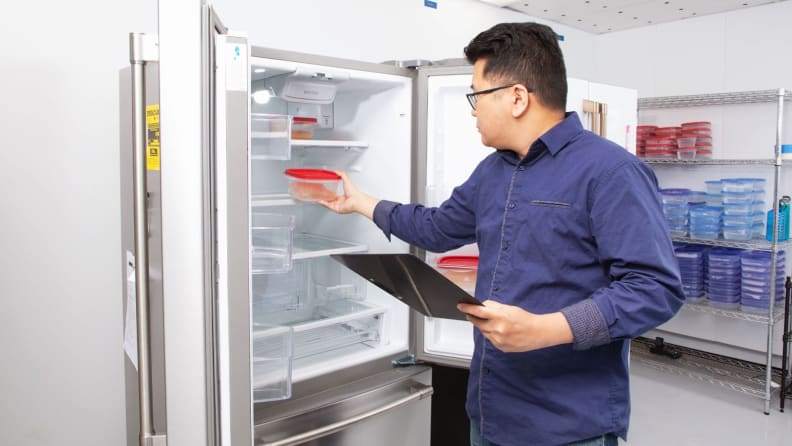
In addition to the hard data of our objective tests, we also have softer, more subjective tests that evaluate how it feels to actually use the fridge.
While hard data is important for knowing how well a fridge can preserve your food, we also try to be mindful of how the fridge feels to use.
There are dozens of ways that a cheap fridge may annoy you, where a well-designed fridge may make you feel like you're living in the lap of luxury.
For this test, we simply use the fridge as we would our own fridge at home. We look at the doors, shelves, controls, water/ice dispenser, and more. We check extras like smart connectivity, door-in-door or flexible storage options.
Do the drawers slide smoothly? How easy is it to reposition bins and shelves? How easy is it to calibrate the fridge or adjust the temperature later? Is it lit by a single bulb, or does it have an entire wrap-around array of LEDs illuminating every corner—potentially letting you spot those leftovers before they go bad?
You get the idea.
If a refrigerator keeps the temperature at a perfect 37°F, but it’s difficult to open the doors and the control panel makes no sense, that fridge gets penalized with respect to its ease of use.
We adapt our testing as fridge technology evolves
While it's important to keep our testing consistent to ensure fridges we review today can be compared to those we reviewed a decade ago, we also need to update our tests to reflect newer innovations in refrigerator technology.
"Our test program evolves with fridge technology," states Ellerby. "For example, flexible use zones with a range of temperature settings are increasingly common. These allow you to select temperatures perfectly tailored for specific tasks, like chilling wine. We’ve expanded our test program to check that these features function correctly."
Jonathan Chan, our senior manager of lab operations, adds, "Whether it's a temperature drawer or one designed to preserve produce, we're designing new tests to ensure that these features live up to the manufacturers' claims."

